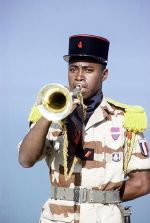Bugle (instrument)
The bugle is one of the simplest brass instruments; it is essentially a small natural horn with no valves. All pitch control is done by varying the player's embouchure, since the bugle has no other mechanism for controlling pitch. Consequently, the bugle is limited to notes within the harmonic series. See Bugle call for scores to standard bugle calls.

The bugle developed from early musical or communication instruments called "horns" because they were made of animal horns. (Cf. Shofar.) The word "bugle" comes from the Latin word "buculus" (young bull) via the French "bugleret". The first bugles developed as hunting horns. They were shaped in a coil — typically a double coil, but also a single or triple coil — similar to the modern French horn, and were used to communicate during hunts and as announcing instruments for coaches (somewhat akin to today's automobile horn). Predecessors and relatives of the developing bugle included the post horn, the Pless horn (sometimes called the "Prince Pless horn"), and the bugle horn.
The first verifiable formal use of a brass horn as a military signal device was the Halbmondblaser — literally, "half moon blower" — used in Hanover in 1758. It was U-shaped (hence its name) and comfortably carried by a shoulder strap attached at the mouthpiece and bell. It first spread to England in 1764 where it was gradually accepted widely in foot regiments. Cavalry did not use a proper bugle, as a rule, but rather a trumpet; this might be mistaken for a bugle today, as it could lack keys or valves, but it had a more gradual taper and a smaller bell, producing a sound more easily audible at close range but with less carrying power over distance.
The bugle is used mainly in the military and in drum and bugle corps, where the bugle has evolved away from its military origins, growing valves. In American drum and bugle corps, G is considered the traditional key for bugles to be pitched in. Civilian drum corps were founded using equipment sold off by the military in the early 1900s, and the last official change made to the military bugle before its role as a signaling device was rendered obsolete by the radio was to standardize them in the key of G. Bugles in other parts of the world typically were pitched in B flat or E flat.
The cornet is sometimes erroneously considered to be the "valved version" of the bugle, although it was derived from the French cornet de poste (post horn).
19th century variants based on the standard bugle included keyed bugles and valved bugles. Keyed bugles were invented in England in the early 19th century, with a patent for one design, the Royal Kent bugle, taken out by Joseph Halliday in 1811. This bugle was highly popular and wide in use until c1850, so for example in works by Richard Willis, later bandmaster of the United States Military Academy Band at West Point. This variant of the bugle fell out of use with the invention of the valved cornet.
ReferencesISBN links support NWE through referral fees
- Baines, Anthony, Brass instruments: their history and development, NY: Scribner, 1976. ISBN 0-684-15229-0
- Blair, Tom; Clark, Jeff, Drum Corps International 2006 world championships, August 8-12, Madison, Wisconsin, Vol 2., Div. 1, Addison, Ill.: Drum Corps International, 2006. OCLC 81946195
- Hopkins, William B.; Marshall, S.L.A., One bugle, no drums: the Marines at Chosin Reservoir, Chapel Hill, N.C.: Algonquin Books of Chapel Hill, 1986. ISBN 0-912-69745-8
External links
- Evolution of the Bugle Retrieved October 18, 2007.
Credits
New World Encyclopedia writers and editors rewrote and completed the Wikipedia article in accordance with New World Encyclopedia standards. This article abides by terms of the Creative Commons CC-by-sa 3.0 License (CC-by-sa), which may be used and disseminated with proper attribution. Credit is due under the terms of this license that can reference both the New World Encyclopedia contributors and the selfless volunteer contributors of the Wikimedia Foundation. To cite this article click here for a list of acceptable citing formats.The history of earlier contributions by wikipedians is accessible to researchers here:
The history of this article since it was imported to New World Encyclopedia:
Note: Some restrictions may apply to use of individual images which are separately licensed.
